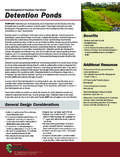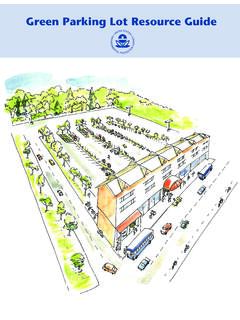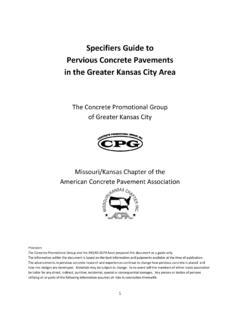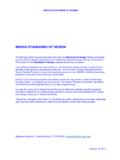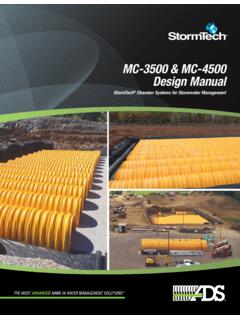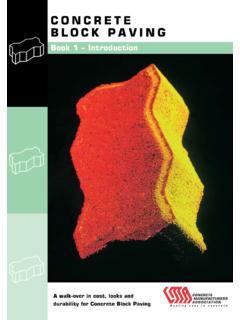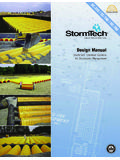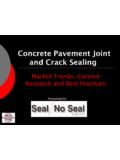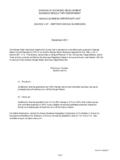Transcription of Porous Concrete fact sheet - Dauphin County
1 Best Management Practices fact SheetPorous ConcretePURPOSE: Porous Concrete used in place of conventional Concrete decreases thetotal amount of runoff leaving a site, promotes infiltration of runoff into the ground,reduces the amount of pollutants carried to a storm drain or waterway, and aids withreducing peak runoff velocity and land for residential, commercial and industrial use carries the detrimentaleffect of vastly increasing the amount of impervious surface area as land is paved tocreate roads and parking lots. During a storm, runoff flows over impervious pavement,picking up pollutants such as dirt, grease and oil, and transports these contaminantsto streams and storm sewer response to this issue, designers developed Porous paving systems that allowrunoff to pass through the pavement into a stone reservoir, before infiltrating the soilbelow to recharge the groundwater supply.
2 With proper installation and maintenance, Porous paving allows for infiltration of up to 80% of annual runoff volume. Additionally,studies indicate that Porous Concrete systems can remove up to 65% of undissolvednutrients from runoff and up to 95% of sediment in design for application of Porous Concrete consists of at least three layers: a two tofour-inch layer of Porous Concrete , a one to two-inch filter layer of half-inch crushedaggregate, a 12-inch minimum reservoir layer of one to three-inch aggregate, and anoptional layer of filter fabric. Porous Concrete consists of a mix including Portlandcement, uniform open-graded coarse aggregate, and water.
3 The void space ofporous Concrete ranges between 15% and 22%, compared to a three to five percentvoid space in conventional Concrete . The Concrete itself provides for some pretreatmentof runoff. The crushed aggregate filter layer aids with removing some is stored in the reservoir bed, a highly permeable layer of open-graded clean-washed aggregate with at least 40% void space. The filtered runoff then percolatesthrough the uncompacted soil base into the groundwater Concrete is placed using forms, then leveled with a screed. No finishing isrequired, and jointing is optional. Take care not to overwork the Concrete is applicable to many light-duty uses, including overflow parkingareas, residential street parking lanes, parking pads in parking lots, sidewalks, golfcart and bike paths, and emergency access lanes.
4 With proper maintenance, includingregular vacuuming of the surface to prevent clogging by sediment, Porous concretecan have a minimum service life of 20 : Installing a berm at the edge of Porous paving keeps off-site runoffand sediment from entering the Porous paved surface area, which prevents subsurface drain may be incorporated into the design of the stone reservoir tocollect water and route it to a detention or infiltration : Porous paving materials are not effective at removing dissolved nutrients fromwater; therefore, they should be located at least 100 feet from drinking water of runoff is necessary where oil.
5 Grease or other groundwatercontaminants are Concrete Conventional concreteA close up comparison shows the difference invoid space between conventional and ResourcesPA Department of Environmental Protection- Pennsylvania Stormwater Best ManagementPractices ManualUS Environmental Protection - click on Technologies for projectexamples and general informationVillanova Urban Stormwater and Uses Reduces total amount of impervious cover Reduces peak velocity and volume of stormwaterrunoff delivered to storm sewer system Alleviates flooding and erosion downstream Applicable to all types of sites (residential/commercial/industrial)
6 Recharges groundwater supply Filters contaminants from runoff prior to itsdischarge to the storm sewer system Allows for land use in areas that otherwise wouldnot meet stormwater retention guidelines Requires less need for curbing and storm sewersGeneral Design Considerations Test soil at least four feet below base of stonereservoir for permeabilityof at least inch per hour Porous surface permeability should be at leasteight inches per hour Suitable for drainage area of less than 15 acres Existing soil base must be level to preventponding under the system Avoid compaction of soil base; if new fill isrequired, the addition of stone is recommendedover adding compacted soil Install at least four feet above seasonal highgroundwater table to prevent contamination Design should include overflow drainage toremove excess stormwater Perforated pipe placed in the stone bed willdistribute runoff evently throughout bed andmay provide additional storage volume,depending on size of pipe Stone bedding layer should drain within 72hours of a rain event Slope of pavement surface should be no greaterthan 5%.
7 2% grade is recommended Aggregate for reservoir bed should beapproximately 1 to 3 inches in diameter Reservoir aggregate must be clean-washedand contain at least 40% void space Reservoir layer should be at least twelve inchesdeep Air temperature during Concrete pour must be atleast 50 F Porous Concrete sets up quickly Take care not to overwork Porous concretesurface Design of system should consider expected typeand frequency of usage Control of sediment is critical - remove surfacesediment with a vacuum or by sweeping; avoidpower-washing, as it will clog the system Design must provide for a backup method forwater to enter stone reservoir ( stone-edged drain near wheel stop if curbing is not inplace) Concrete should be covered with polyethylenefilm for at least one week to aid with curing Not suitable for stormwater hot spots , suchas truck stops, gas stations, etc.
8 Due to highlevel of contaminants present Use snow plows with caution during snowremoval Prohibit use of sand, ash, salt or de-icers Installation in areas of high traffic or heavyvehicles not recommended Not recommended in areas where winderosion supplies significant amounts ofwindblown sediment Post signs to prevent vehicles with muddytires from entering area Potholes and cracks may be patched withtraditional patching mix, unless more than10% of Porous surface area needs to berepairedProceed with CautionThough permeable paving materials have been in existence sincethe 1970 s, their implementation has been slow, due predominantlyto unfamiliarity with correct procedure, leading to faulty installation,and a subsequently high rate of failure.
9 However, with properinstallation and maintenance, these systems can be very effectiveand long-lasting. Key design factors to ensure optimum pollutantremoval and longevity include: Placement in areas with highly permeable soils;if underlying soil is damp, microbiological decompositionof pollutants may be impeded Existence of organic material in soil Vacuum sweeping on a quarterly schedule Use in low-density parking areas Restrictions on use by heavy vehicles Limited use of de-icing chemicals Inspection and enforcement of specifications during construction Pretreatment of runoff to paved area Implementation of a sediment control plan Extending the depth of reservoir level to belowthe frost line to prevent subgrade from frost heave1.
10 (above) Site is (above) Stone base layer is poured,spread and (above) Concrete is poured and (above) Concrete is leveled with a (above) Work edges and surface toa clean (right) Cover area for curing ConcreteInstallatio
